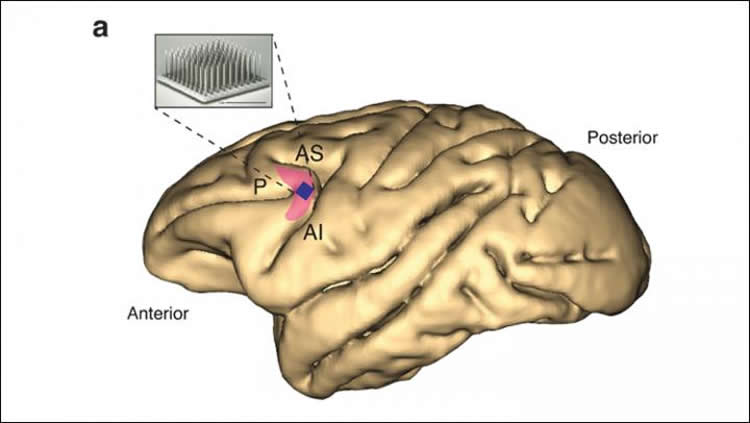Summary: Even at doses that help improve monkeys’ attention, researchers observe no differences of neural activity in the prefrontal cortex after administering Ritalin.
Source: SfN.
In contrast to studies of mice and rats, new research published in eNeuro investigating the effect of methylphenidate (Ritalin) on neuronal activity in monkeys has found no effect of the drug on the prefrontal cortex. The study leaves open the question of how and why Ritalin improves attention in humans.
Julio Martinez-Trujillo and colleagues refute their hypothesis the caudal prefrontal cortex– a brain region critical for attention — is Ritalin’s main site of action in the brain. To arrive at this conclusion, the researchers recorded large populations of neurons in this brain region as two male macaque monkeys performed a demanding visual attention task. The team did not observe any differences in neuronal activity after administration of the drug compared to a placebo, even at doses that improved the monkeys’ performance on the task.

These negative results do not rule out other regions of the prefrontal cortex as possible sources of Ritalin’s action in the brain. In addition, they highlight the difficulty of translating preclinical research from rodents to nonhuman primates and call for improved collaboration between scientists investigating common questions using different animal models.
Funding: Canadian Institutes of Health Research, Natural Sciences and Engineering Research Council, EJLB Foundation funded this study.
Source: David Barnstone – SfN
Publisher: Organized by NeuroscienceNews.com.
Image Source: NeuroscienceNews.com image is credited to Tremblay et al., eNeuro (2019).
Original Research: Abstract for “The effects of methylphenidate (Ritalin) on the neurophysiology of the monkey caudal prefrontal cortexs” by Sébastien Tremblay, Florian Pieper, Adam Sachs, Ridha Joober and Julio Martinez-Trujillo in eNeuro. Published February 25 2019.
doi:10.1523/ENEURO.0371-18.2018
[cbtabs][cbtab title=”MLA”]SfN”Ritalin Has No Effect on Primate Prefrontal Cortex.” NeuroscienceNews. NeuroscienceNews, 25 February 2019.
<https://neurosciencenews.com/ritalin-pfc-primate-10805/>.[/cbtab][cbtab title=”APA”]SfN(2019, February 25). Ritalin Has No Effect on Primate Prefrontal Cortex. NeuroscienceNews. Retrieved February 25, 2019 from https://neurosciencenews.com/ritalin-pfc-primate-10805/[/cbtab][cbtab title=”Chicago”]SfN”Ritalin Has No Effect on Primate Prefrontal Cortex.” https://neurosciencenews.com/ritalin-pfc-primate-10805/ (accessed February 25, 2019).[/cbtab][/cbtabs]
Abstract
The effects of methylphenidate (Ritalin) on the neurophysiology of the monkey caudal prefrontal cortex
Methylphenidate (MPH), commonly known as Ritalin, is the most widely prescribed drug worldwide to treat patients with attention deficit disorders. Although MPH is thought to modulate catecholamine neurotransmission in the brain, it remains unclear how these neurochemical effects influence neuronal activity and lead to attentional enhancements. Studies in rodents overwhelmingly point to the lateral prefrontal cortex (LPFC) as a main site of action of MPH. To understand the mechanism of action of MPH in a primate brain, we recorded the responses of neuronal populations using chronic multielectrode arrays implanted in the caudal LPFC of two macaque monkeys while the animals performed an attention task (N = 2811 neuronal recordings). Over different recording sessions (N=55), we orally administered either various doses of MPH or a placebo to the animals. Behavioral analyses revealed positive effects of MPH on task performance at specific doses. However, analyses of individual neurons activity, noise correlations, and neuronal ensemble activity using machine learning algorithms revealed no effects of MPH. Our results suggest that the positive behavioral effects of MPH observed in primates (including humans) may not be mediated by changes in the activity of caudal LPFC neurons. MPH may enhance cognitive performance by modulating neuronal activity in other regions of the attentional network in the primate brain.
Significance Statement
Methylphenidate (MPH), widely known as Ritalin, is the most prescribed drug to treat patients with attention deficits. Nonetheless, it is still unclear how and why the drug improves attention in humans. Studies in rodents point to the prefrontal cortex (PFC) as the main target of MPH. To validate these findings in primates, we trained macaque monkeys to perform an attention task while under various doses of MPH. We also chronically implanted multielectrode arrays in the posterior PFC of these monkeys to record neuronal ensemble activity during the task. Surprisingly, we found no effect of the drug on neuronal activity, even at cognitive-enhancing doses of MPH. The caudal prefrontal cortex might not be the site of action of MPH in the primate brain.






